ASRock Fatal1ty Z77 Professional Review - IDE and Floppy on Z77
by Ian Cutress on May 20, 2012 1:30 PM EST- Posted in
- Motherboards
- ASRock
- Fatal1ty
- Z77
ASRock Fatal1ty Z77 Professional BIOS
In order to keep everything Fatal1ty branded, the BIOS also gets a visual overhaul – red and back being the theme of the branding makes its way onto our screens. I have seen on BIOSes of older motherboards that the background in fact had our good mate’s face on every page. Luckily this is not a concern here – we are left with the Fatal1ty ‘F’ symbol as seen on the chipset heatsink on board.
While ASRock do not have the best BIOS style wise out of the current sphere of options, they make a very good go at it, have some unique features, and it is quite easy to use. The primary screen contains some of the sort of information we need to know when we enter a BIOS – the board and BIOS version, the CPU model and speed, the amount of memory present and also the speed that the memory is currently running. It would also be nice to see some CPU temperatures/voltages, as well as the boot order or XMP settings of the memory if present.
Of note on this screen are the two options at the bottom – System Browser and Online Management Guard (OMG). The first is a similar frontage to what Gigabyte are doing with their 3D BIOS, except this time it is just a top down view of the board showing what is plugged in where:
Whilst OMG is an inventive name for the Online Management Guard, the reality of this feature is the ability to set hours of the day that the board will disable all online activity. So if a parent wants to limit their child’s internet access to just an hour on a school night, this feature is useful for that. The downside of the feature is that if the child is savvy enough, they can enter the BIOS and deselect the options such that the internet will work again.
Overclocking features are found in the OC Tweaker Menu, which offers either a selection of preset overclocks (just tables of values to be used, no explicit thorough testing so YMMV), or users can insert individual overclocks underneath. All the settings needed for a reasonable overclock are here, although I could think of one or two ways to lay it out better.
By default, the floppy drive controller is disabled. In order to enable it, navigate to Advanced -> Super IO Configuration to find it:
One feature I am liking on the new ASRock Z77 range is the ability to update the BIOS from the internet while in the BIOS itself. Under the Advanced Menu, the Internet Flash option will enable your network controller and look for Internet in order to probe the ASRock servers for updates.
For monitoring temperatures or BIOS fan control, the H/W Monitor screen has all the information:
As I have said before on ASRock boards, their philosophy of referring to fan controls in the form of ‘levels’ is somewhat confusing – while it is clear that Level 10 should be more powerful than Level 4, we are in a day and age where people would rather deal with hard numbers. These settings, rather than absolute temperature values, may be indicative of the fan controllers that ASRock use.
One interesting novel setting that ASRock now have is the ‘Dehumidifier Function’. This essentially tells the motherboard to keep the fans running at a speed after the system is set into sleep, similar to the feature now on ASUS Sabertooth motherboards.
One issue I did come across with the motherboard is the ability to run my G.Skill RipjawsZ DDR3-2400 9-11-11 4x4 GB memory kit, which is the kit I am using at XMP for all Ivy Bridge/Z77 testing. On most motherboards, this kit will run fine at XMP without issue – in others it either refuses to boot, or requires extra voltage to run. In the Fatal1ty Z77 Professional, I had to set the voltage of the memory to ~1.70 volts. Even at this level, the board only booted successfully about 40% of the time – and thus I had to endure reboots until the memory worked successfully. I was unable to set the memory timings and sub-timings manually as their XMP values fell outside of the range that ASRock gives the user to adjust. ASRock are aware of this issue, and chances are that this will be fixed in a later revision of the BIOS.
Software
ASRock software has been pretty fixed over the past few ASRock motherboards I have tested and reviewed. At the heart of the software is a trio of XFast functionality – LAN, RAM and USB, two of which are re-branded and licensed software from other companies. On top of all this is the ASRock Extreme Tuning Utility (AXTU), which for the purposes of Fatal1ty branded motherboards is renamed F-Stream.
F-Stream:This software houses most of ASRock’s software, from monitoring tools to OS overclocking tools, power saving tools, the Fatal1ty Mouse Port tool, and XFast RAM.
Fan control is similar to the BIOS in many respects – the controllable fans (all those not labeled CPU or Chassis) have options from Level 1 to Level 10 for power. Compared to solutions on other manufacturers' products, this is rather poor – no setting of a power gradient for fans, nor are there actual temperature selections. As per the screen above, the only temperature option is ‘Target Temperature’, which essentially tells the fans to run at full speed if the system rises above that temperature. Perhaps some more advanced fan controllers are needed on the board to make this feature more palatable to users concerned with temperatures.
The Fatal1ty Mouse Port tool is not one I have covered before, but the premise is simple – change the driver settings so that the movements of the mouse are updated more often to the system. This should (theoretically) improve the mouse responsiveness in games. Though I can see some problems with this:
A system using V-Sync is limited to a max 60 Hz – from output to the screen as well as mouse movements as the system has to synchronize all I/O. So no matter the polling rate on the board, you are limited to that V-Sync setting. Without V-Sync, you are limited to how often the computer updates – usually limited by the GPU in this case which synchronizes output with the display. With a mixture of Virtu MVP and Virtual V-Sync, these can be overcome due to the Virtualization layer these technologies afford. It also depends on whether the mouse can support it – my regular test bed mouse is a Dell 6-button laser mouse (do not laugh, it was cheap and does the job great!), but it will only perform to a maximum of 125 Hz:
The other main F-Stream functionality is XFast RAM, which allows a user to create a RAMDisk for quick access (swap files, temporary files) or for users of 32-bit operating systems to utilize memory above 3.25 GB in the form of a RAMDisk.
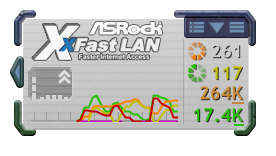
XFast LAN is an ASRock branded licensed copy of cFosSpeed, a network management tool. The program applies a software layer between the OS and the network ports in order to monitor and control the flow of data – programs can be ordered in terms of priority for network resources. The main example that ASRock likes to give is the ping during World of Warcraft whilst actively downloading via Bittorrent – by prioritizing World of Warcraft, the in-game ping comes back to a more normal level while Bittorrent still has access to the rest of the connection.
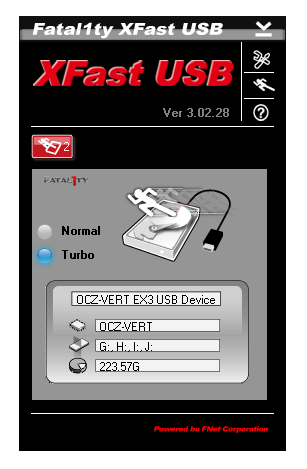
XFast USB software is only different in terms of the Fatal1ty branding compared to previous iterations. The premise behind XFast USB is to override the USB driver in Windows to one that accepts protocols more beneficial to rapid file transfer at the expense of latency. As a result, in our copy tests (involving 100 MB of 1000+ small files and 1.2 GB of large video), the XFast USB solution often performs as one of the best USB implementations on the market. The only downsides are the limitation to one USB device at a time (either USB 2.0 or USB 3.0), and that this software is separate to the main F-Stream interface. It would be nice to see it integrated into the F-Stream software.



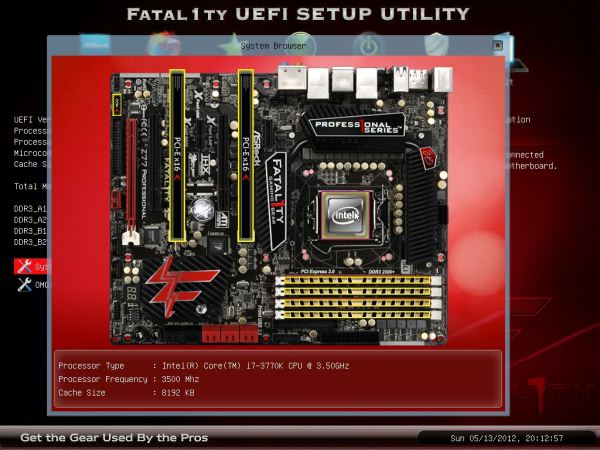
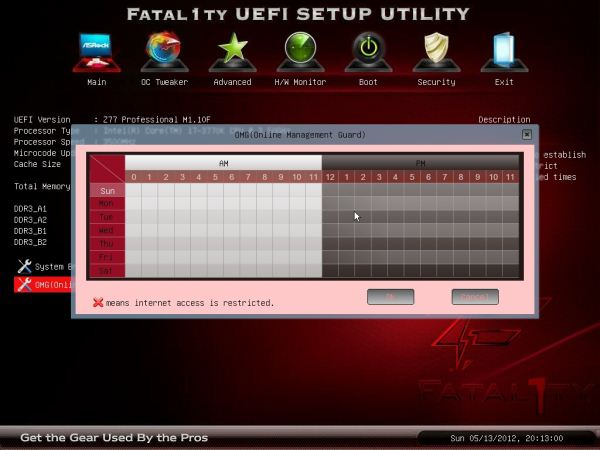

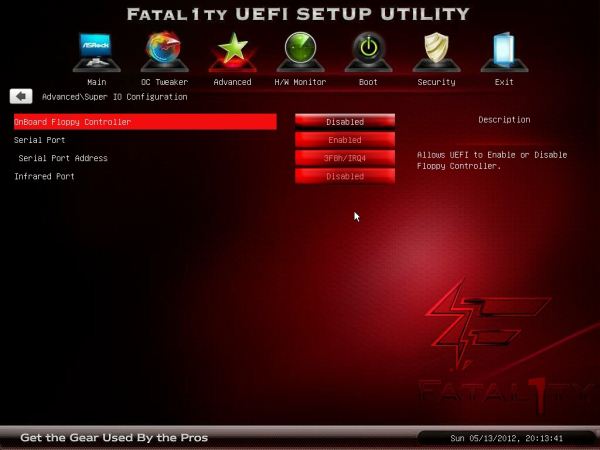
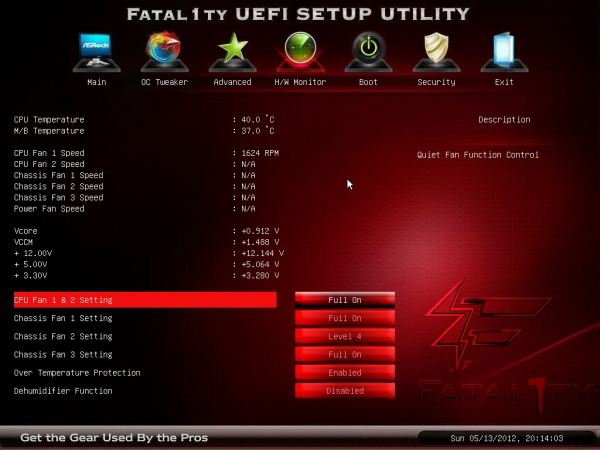






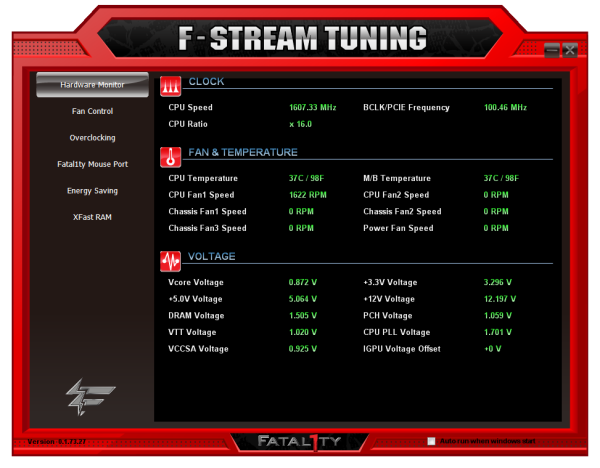
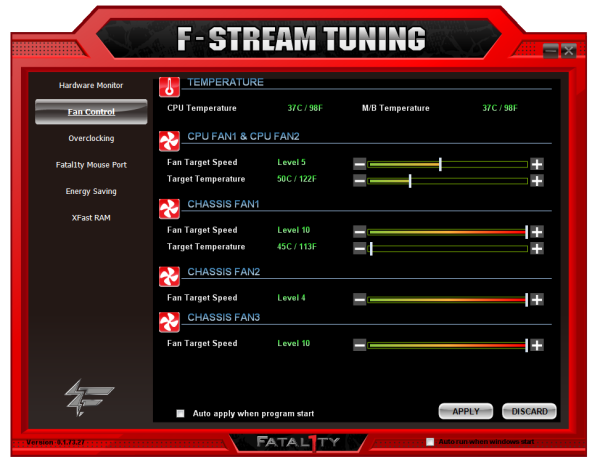
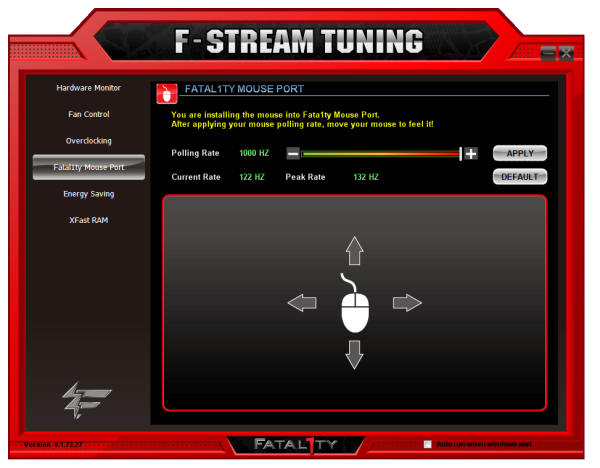














57 Comments
View All Comments
borden5 - Tuesday, May 22, 2012 - link
idk about you guy but i won't buy something that just because of a person image on it, it doesn't feel special about the board since whenever i think of my motherboard that guy pop up instead of something else, i'd rather prefer asrock sticker on it than this crap.kam24 - Tuesday, May 22, 2012 - link
I was looking through the Z77's on Newegg and this caught my attention because of IDE. I'll probably retire my old IDE hard drives along with my dusty old floppy (my current OS drive is SATA and I'll keep that for extra storage)...but I have two IDE optical drives with custom painted face plates. Nothing fancy but I'd like to reuse them. I was disappointed though with how the board fared in this review. When paying this much for a board I'd expect better power management and more polish. I don't care either way about the branding aspect.I'd just like to, as someone else mentioned, be able to take a bare bones board and add what I'd like. I wonder how much it would cost a company like MSI or Asus to offer that. I'd pay a little extra for a board perfect for me.
frankanderson - Wednesday, May 23, 2012 - link
You guys know that they do sell IDE enclosures for old school drives and external DVDRW/BR devices right? I have a external usb floppy which I only use to boot up old motherboards that don't like to boot off USB thumb drive for some reason, or insert SCSI driver into floppy.. I just don't like having a floppy in my system anymore, I don't even have a DVD installed, the DVD is installed in my Home Server, I'll network whatever data over that I need, most of my games and apps are digital copies now, they are downloaded in a simple install package and left on my server, can't remember the last time I actually bought a software in a box (I think it was Windows 7 Ulitimate which was years ago)..Another thing is "Wendal" is a great gamer, a pro gamer and probably one of the greatest out there, sure it's a dream that someone can do what they love and still make a living from it.. I just don't believe that because it's "endorsed" by him, means that it's the best product..
And where I am from, most "endorsed" products are just for publicity, us as consumers don't really believe they really use that product at home, even if it's free.. just my $0.02
smithrd3512 - Wednesday, May 23, 2012 - link
Looks like I can put a 5.25" floppy on my new build with this board.Would give the kids something to ask me what the heck is a floppy.
redwolfe98 - Monday, June 4, 2012 - link
i disagree that a floppy connector is not needed.. it is needed if you are running "windows xp", as i am..read how to flash the bios on a MSI motherboard, which doesn't have a floppy connector, when running win xp:
"get yourself an external floppy drive with a USB connector; add files to floppy disk so that the external floppy drive is recognized (if it works as intended); if all goes well ie if the external floppy drive is recognized, proceed to flash bios..
i remember when Dell quit shipping floppy drives.. lots of people weren't able to install the drivers that were needed for "sata", because they didn't have a floppy drive, and, consequently, had to switch things in the bios to "IDE compatibility"..
i don't see any reason for not including a floppy connector, at least not until windows xp is dead and buried and long forgotten..
i also like using PS/2 connections for mice and keyboards..
spencerp - Monday, June 4, 2012 - link
I bought a gamer computer back in the day (the HP Blackbird 002 with Voodoo DNA). It has an optical drive with a proprietary LED/button AND it's IDE. It still plenty fast for the occasional optical drive use.Due to the ASRock motherboards supporting both the IDE and legacy CPU coolers, it has allowed me to continue to breath new life into my hardware and use my Blackbird (I have the older, but nearly identical z68 version).
It's got pretty heavy branding which is extremely obvious out of the box. However, when the video cards and CPU cooler is installed, it's not as bad.
http://www.flickr.com/photos/spthealien/6387705167...
It has been rock solid.
DreadStorm - Friday, May 2, 2014 - link
Instead of bitching about WHY people use floppies and EIDE, why not just accept the fact that some of us still do - and leave it at that? There are several useful reasons to still use a floppy - or other obsolete removable media - the main one being that no one else has such drives, and what better way to secure data than to place it on a medium that no one else has? USB, Firewire, rack-mounted hard drives, all suffer the same similarity: Everyone has them, and can connect to and try to crack into them. With a floppy, Orb, Zip, Jaz, hell even a 5.25", no one uses anymore, so it makes the data that much more secure against hack attempts. "Old school" hardware still has a number of useful applications nowadays. Personally, I have about 12 different obsolete removable media drives connected to my Fatal1ty Z77 Pro (most via SCSI card). And all work like a champ - except for the floppy drive controller on this board, which had never worked since day one. For the floppies, I have an older P4 machine networked together for those, because of the floppy connector issue on this board.If they ever got it fixed, I wouldn't need the older machine anymore. But other than that, I have no intention of relieving myself of older media. If for nothing else than nostalgia and uniqueness.